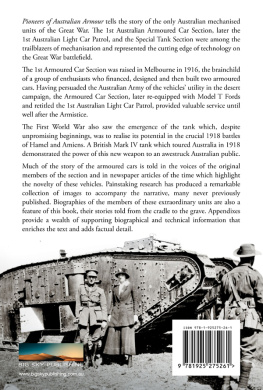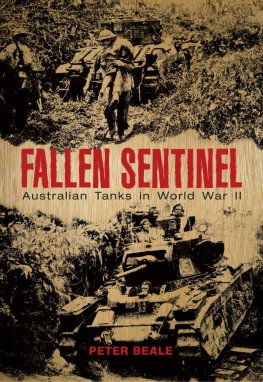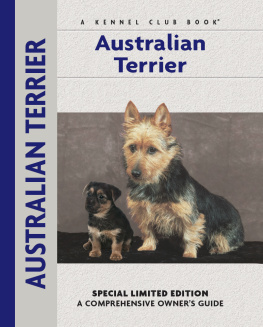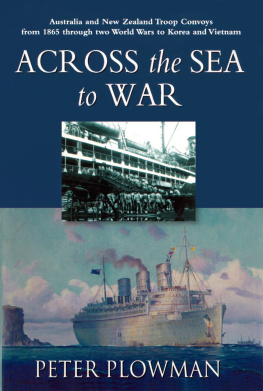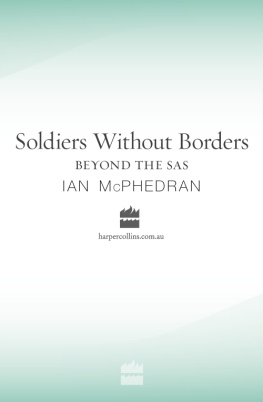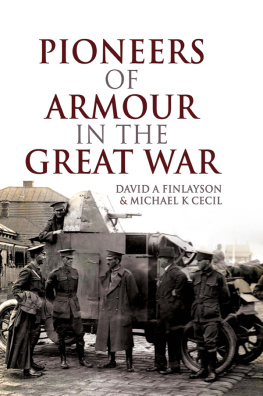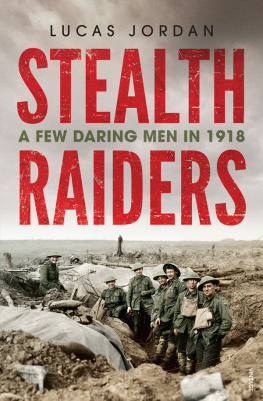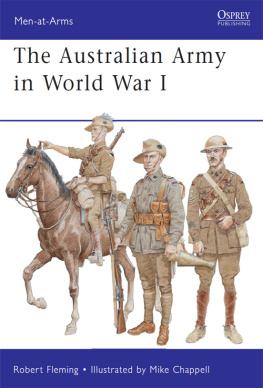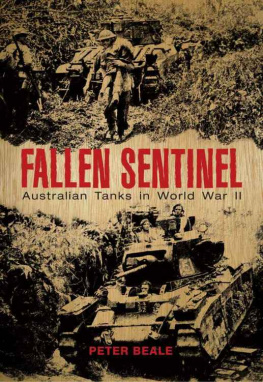PIONEERS
OF AUSTRALIAN
ARMOUR
In the Great War
Copyright David A Finlayson & Michael K Cecil
First published 2015
Copyright remains the property of the Commonwealth and apart from any fair dealing for the purposes of private study, research, criticism or review, as permitted under the Copyright Act, no part may be reproduced by any process without written permission.
All inquiries should be made to the publishers.
Big Sky Publishing Pty Ltd
PO Box 303, Newport, NSW 2106, Australia
Phone: | 1300 364 611 |
Fax: | (61 2) 9918 2396 |
Email: |
Web: | www.bigskypublishing.com.au |
Cover design and typesetting: Think Productions
National Library of Australia Cataloguing-in-Publication entry (pbk.)
Author: | Finlayson, David A., author. |
Title: | Pioneers of Australian armour : in the Great War / David A Finlayson, Michael K Cecil. |
ISBN: | 9781925275261 (hardback) |
Subjects: | Australia. Army. Royal Australian Armoured CorpsHistory. |
Australia. Army. Light Car Patrol, 1stHistory. |
Armored vehicles, MilitaryAustraliaHistory. |
Tanks (Military science)AustraliaHistory. |
World War, 1939-1945Participation, Australian. |
AustraliaArmed ForcesEquipmentHistory. |
Other Creators/Contributors: Cecil, Michael K.
Dewey Number: 940.541294
PIONEERS
OF AUSTRALIAN
ARMOUR
In the Great War

David A Finlayson & Michael K Cecil
THE AUSTRALIAN ARMY HISTORY COLLECTION
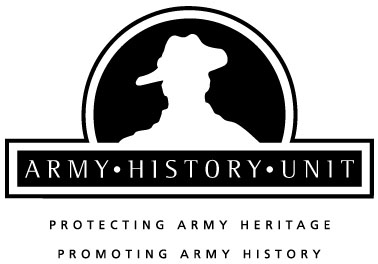
Winning with Intelligence
Judy Thomas
Duntroon
Darren Moore
The Warrior Poets
Robert Morrison
The History of the Royal Australian Corps of Transport 19732000
Albert Palazzo
Defenders of Australia
Albert Palazzo
The Fight Leaders
D. Butler, A. Argent and J. Shelton
Operation Orders
Pat Beale
Little by Little
Michael Tyquin
Red Coats to Cams
Ian Kuring
Bowler of Gallipoli
Frank Glen
Vets at War
Ian M. Parsonson
Only One River to Cross
A.M. Harris
The Fragile Forts
Peter Oppenheim
Hassett: Australian Leader
John Essex-Clark
Persian Expedition
Alan Stewart
The Chiefs of the Australian Army
James Wood
Never Late
Gordon Dickens
To Villers-Bretonneux
Peter Edgar
Madness and the Military
Michael Tyquin
The Battle of Anzac Ridge 25 April 1915
Peter D. Williams
Doves Over the Pacific
Reuben R.E. Bowd
The Lionheart
David Coombes
Battlefield Korea
Maurie Pears
Chemical Warfare in Australia
Geoff Plunkett
A Most Unusual Regiment
M.J. Ryan
Between Victor and Vanquished
Arthur Page
Country Victorias Own
Neil Leckie
Surgeon and General
Ian Howie-Willis
Willingly into the Fray
Catherine McCullagh
Beyond Adversity
William Park
Crumps and Camouflets
Damien Finlayson
More than Bombs and Bandages
Kirsty Harris
The Last Knight
Robert Lowry
Forgotten Men
Michael Tyquin
Battle Scarred
Craig Deayton
Crossing the Wire
David Coombes
Do Unto Others
Alan H Smith
Fallen Sentinel
Peter Beale
Sir William Glasgow
Peter Edger
Training The Bodes
Terry Smith
Bully Beef and Balderdash
Graham Wilson
Fire Support Bases Vietnam
Bruce Picken
Toowoomba to Torokina
Bob Doneley
A Medical Emergency
Ian Howie-Willis
Dust, Donkeys and Delusions
Graham Wilson
The Backroom Boys
Graeme Sligo
Captains of the Soul
Michael Gladwin
For the pioneers of Australian armour during the Great War: the members of the 1st Australian Armoured Section, 1st Australian Light Car Patrol and the Special Tank Crew.
CONTENTS
List of illustrations and maps
Part 1
Part 2
List of diagrams
List of Maps
The Australian understanding of the Great War reflects the experiences of the infantry and light horse at Anzac and in the Middle East, France and Flanders, with the endeavours of small units sometimes lost within the big picture. Furthermore, our knowledge of armoured cars and tanks in this time period is based on the way British units operated them with our forces. As such it is understandable that the genuinely Australian experience of armour has been largely overlooked.
This uniquely Australian experience of armour can be found, however, in the stories of two little-known units: the Australian Armoured Car Section, later the 1st Australian Light Car Patrol, which operated from 1915 to 1919, and the Special Tank Section, AIF, formed in 1918. Both units embraced the power of the internal combustion engine, the firepower of machine-guns, and the protection of armour to demonstrate a new form of mechanised warfare on both wheels and tracks.
Lieutenant Ernest James and a small group of Edwardian motor enthusiasts designed, funded and constructed two armoured cars in Melbourne during 191516. Despite the potential challenges, particularly that of the hostile desert terrain, the Australian Armoured Car Section took these vehicles to the Middle East in 1916. Later re-equipped with Model T Fords and a change of title to the 1st Australian Light Car Patrol, the unit would demonstrate the value of speed, firepower and manoeuvre on wheels during the 191718 campaigns and the period immediately following the armistice with Turkey.
The story of Grit, Australias first tank, began in 1917 when the Australian government requested its British counterpart to provide a tank for fundraising and recruiting purposes. Australian Army Service Corps drivers and artificers were trained at Bovington in the United Kingdom and then formed into the Special Tank Section, AIF, before travelling to Australia to await their vehicle. Grit, a Mk. IV (Female) tank, arrived in Port Melbourne in 1918. Over the next few years Grit and her successive crews demonstrated the capability of tanks to an awestruck public as they toured eastern Australia. Grit would eventually find a place of honour in the National Collection at the Australian War Memorial.
Pioneers of Australian Armour seeks to recognise the work of the members of these two small Australian units operating armoured fighting vehicles during the Great War. Their pioneering efforts laid the foundations for mechanised warfare and armour within the Australian Army.
In 2005, when this project was first considered, it seemed relatively straightforward. Captain James unpublished manuscript The Motor Patrol, a little-known but complete text, was held at the Australian War Memorial and there was a small quantity of images available to support the text. Mike Cecil had documented Grits history and that of the Special Tank Section over many years. The task was limited and appeared simple. However, by 2012, the situation had changed markedly: the internet and the current process of digitisation had produced a harvest of primary documents that could not have been accessed just a few years previously. The National Archives of Australia and the National Library website Trove also uncovered a quantity of material that has provided vivid images of the period and the individuals concerned. In addition, the burgeoning interest in family history has produced on-line resources that document a persons life and allow contact between researchers. These contacts have enabled the descendants of members of the two units to participate in the documentation process. Their generous responses have expanded the project dramatically.

